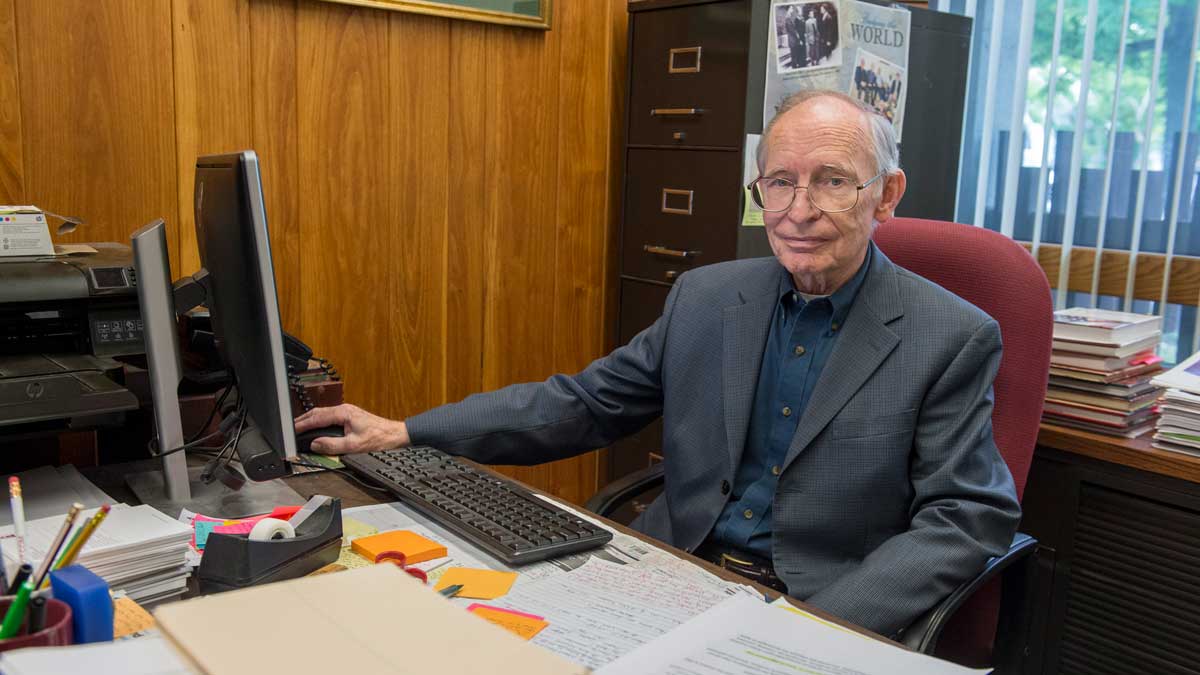
John Jackson, visiting professor, SIU Carbondale Paul Simon Public Policy Institute (Photo by Russell Bailey)
June 05, 2024
SIU Carbondale political scientist studies impact of virtual 2020 Democratic National Convention
CARBONDALE, Ill. — An initial study by researchers including John S. Jackson, a visiting professor at Southern Illinois University Carbondale’s Paul Simon Public Policy Institute, shows that the virtual roll call used by delegates in nominating President Joe Biden at the 2020 Democratic National Convention (DNC) was generally approved.
The same format will be utilized again by DNC delegates in two months. The DNC announced recently that its national convention vote on Biden’s nomination for a second term will be held early by a virtual roll call of each state’s delegates before the convention, set for Aug. 19-22 in Chicago. The decision was necessary because of Ohio’s Aug. 7 ballot access deadline.
The virtual roll call will be similar to the one used due to the COVID-19 crisis four years ago.
The online research survey by Jackson, John C. Green, a distinguished professor of political science at the University of Akron’s Ray C. Bliss Institute of Applied Politics, and Geoff Layman, chair of the political science department at the University of Notre Dame, showed that 2020 delegates were “generally well satisfied with the way their convention was conducted and its success, even though it was historically unprecedented in the use widespread remote presentations rather than the focus being on the thousands of delegates packed into the convention hall.”
This is the first report coming from the online survey and data continues to be analyzed, Jackson said.
Media availability
John S. Jackson, one of the study’s authors, is a visiting professor at the SIU Carbondale Paul Simon Public Policy Institute. and has more than four decades of political expertise and research in presidential politics, campaigns and elections. He can be reached at 618-303-1240 or jsjacson@siu.edu.
The survey included questions on whether the digital format used in 2020 met traditional convention goals, generated enthusiasm among grassroot activists and key constituencies, and the impact persuading independent and swing voters to vote for Biden and vice president Kamala Harris. There also were questions on the technical innovations at the 2020 convention. The questions and key results include:
- Overall, how successful was the digital format of the 2020 Democratic National Convention? — 50% offered positive assessments, 38% negative assessments.
- Persuading independent and swing voters to cast a ballot for Joe Biden and Kamala Harris — 54% positive, 31% negative.
- Conducting regular party business including the platform and rules— 49% positive; 34% negative.
- Building a strong and cohesive organization to carry out the general election campaign — 47% positive; 45% negative.
- Generating enthusiasm and excitement among grassroots activists and key constituencies — 44% positive; 42% negative.
For technical innovations used, the delegates’ views on balance are more positive than their overall assessment of the convention and success with traditional goals. The findings include:
- The decentralized roll call of states from scenic locations in each state — 69% positive; 20% negative.
- Traditional events delivered at diverse locations such as Joe Biden’s acceptance speech — 63% positive: 20% negative.
- The greater reliance on video presentations with high production values — 63% positive; 22% negative.
- The multi-voice keynote address by rising stars within the Democratic Party — 62% positive; 24% negative.
- The greater use of celebrities as masters of ceremonies for the sessions — 53% positive; 31% negative.
Jackson believes the findings show that both the Democratic and Republican parties will continue to expand use of technology to reach voters.
“The national conventions have played an important part in our presidential elections going back to the early 1800’s, serving the roles of officially nominating our presidential and vice presidential candidates, adopting a platform, and holding a pep rally for the fall campaign,” Jackson said. “They also attract a national audience of potential voters who can only be reached via the national media. Ever changing technology now means that the parties must consider how to reach that national audience through virtual events carried by television and social media as they try to attract supporters for their candidates in November.”
Green added that “technological change has long been a factor in party politics, and digital communication is currently a potent source of change — with its own mix of controversies and consequences.”
Layman, though, noted that the survey shows a varied opinions for Democrats to consider.
“I think our results should make Democratic Party officials who are thinking about moving to a virtual convention take pause, because while their activists were pleased with how it worked in 2020, they don’t want to go back to that,” he said.
Survey methodology
Researchers contacted all 2020 convention delegates for which U.S. mail and email addresses could be located multiple times between July 2023 and March 2024. A total of 554 usable responses were obtained and weighted to match the characteristics of the original list of convention delegates by region, delegate type, candidate pledged, and gender.
The resulting data varied little by when delegates participated in the survey. The overall response rate was 21 percent — excluding undeliverable contacts — and the margin of error for the total sample is plus or minus 4.2 percentage points.
